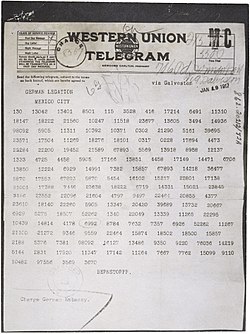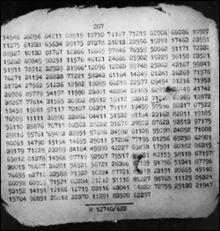In cryptography, a block cipher is a deterministic algorithm that operates on fixed-length groups of bits, called blocks. Block ciphers are the elementary building blocks of many cryptographic protocols. They are ubiquitous in the storage and exchange of data, where such data is secured and authenticated via encryption.

In cryptography, a cipher is an algorithm for performing encryption or decryption—a series of well-defined steps that can be followed as a procedure. An alternative, less common term is encipherment. To encipher or encode is to convert information into cipher or code. In common parlance, "cipher" is synonymous with "code", as they are both a set of steps that encrypt a message; however, the concepts are distinct in cryptography, especially classical cryptography.

Cryptanalysis refers to the process of analyzing information systems in order to understand hidden aspects of the systems. Cryptanalysis is used to breach cryptographic security systems and gain access to the contents of encrypted messages, even if the cryptographic key is unknown.

The Data Encryption Standard is a symmetric-key algorithm for the encryption of digital data. Although its short key length of 56 bits makes it too insecure for modern applications, it has been highly influential in the advancement of cryptography.

In cryptography, the one-time pad (OTP) is an encryption technique that cannot be cracked, but requires the use of a single-use pre-shared key that is larger than or equal to the size of the message being sent. In this technique, a plaintext is paired with a random secret key. Then, each bit or character of the plaintext is encrypted by combining it with the corresponding bit or character from the pad using modular addition.
RSA (Rivest–Shamir–Adleman) is a public-key cryptosystem, one of the oldest widely used for secure data transmission. The initialism "RSA" comes from the surnames of Ron Rivest, Adi Shamir and Leonard Adleman, who publicly described the algorithm in 1977. An equivalent system was developed secretly in 1973 at Government Communications Headquarters (GCHQ), the British signals intelligence agency, by the English mathematician Clifford Cocks. That system was declassified in 1997.

Symmetric-key algorithms are algorithms for cryptography that use the same cryptographic keys for both the encryption of plaintext and the decryption of ciphertext. The keys may be identical, or there may be a simple transformation to go between the two keys. The keys, in practice, represent a shared secret between two or more parties that can be used to maintain a private information link. The requirement that both parties have access to the secret key is one of the main drawbacks of symmetric-key encryption, in comparison to public-key encryption. However, symmetric-key encryption algorithms are usually better for bulk encryption. With exception of the one-time pad they have a smaller key size, which means less storage space and faster transmission. Due to this, asymmetric-key encryption is often used to exchange the secret key for symmetric-key encryption.
In cryptography, the ElGamal encryption system is an asymmetric key encryption algorithm for public-key cryptography which is based on the Diffie–Hellman key exchange. It was described by Taher Elgamal in 1985. ElGamal encryption is used in the free GNU Privacy Guard software, recent versions of PGP, and other cryptosystems. The Digital Signature Algorithm (DSA) is a variant of the ElGamal signature scheme, which should not be confused with ElGamal encryption.
A chosen-plaintext attack (CPA) is an attack model for cryptanalysis which presumes that the attacker can obtain the ciphertexts for arbitrary plaintexts. The goal of the attack is to gain information that reduces the security of the encryption scheme.
Malleability is a property of some cryptographic algorithms. An encryption algorithm is "malleable" if it is possible to transform a ciphertext into another ciphertext which decrypts to a related plaintext. That is, given an encryption of a plaintext , it is possible to generate another ciphertext which decrypts to , for a known function , without necessarily knowing or learning .
A chosen-ciphertext attack (CCA) is an attack model for cryptanalysis where the cryptanalyst can gather information by obtaining the decryptions of chosen ciphertexts. From these pieces of information the adversary can attempt to recover the hidden secret key used for decryption.
In cryptography, a block cipher mode of operation is an algorithm that uses a block cipher to provide information security such as confidentiality or authenticity. A block cipher by itself is only suitable for the secure cryptographic transformation of one fixed-length group of bits called a block. A mode of operation describes how to repeatedly apply a cipher's single-block operation to securely transform amounts of data larger than a block.
The affine cipher is a type of monoalphabetic substitution cipher, where each letter in an alphabet is mapped to its numeric equivalent, encrypted using a simple mathematical function, and converted back to a letter. The formula used means that each letter encrypts to one other letter, and back again, meaning the cipher is essentially a standard substitution cipher with a rule governing which letter goes to which. As such, it has the weaknesses of all substitution ciphers. Each letter is enciphered with the function (ax + b) mod 26, where b is the magnitude of the shift.
In cryptography and steganography, plausibly deniable encryption describes encryption techniques where the existence of an encrypted file or message is deniable in the sense that an adversary cannot prove that the plaintext data exists.
Multiple encryption is the process of encrypting an already encrypted message one or more times, either using the same or a different algorithm. It is also known as cascade encryption, cascade ciphering, multiple encryption, and superencipherment. Superencryption refers to the outer-level encryption of a multiple encryption.
The Cramer–Shoup system is an asymmetric key encryption algorithm, and was the first efficient scheme proven to be secure against adaptive chosen ciphertext attack using standard cryptographic assumptions. Its security is based on the computational intractability of the Decisional Diffie–Hellman assumption. Developed by Ronald Cramer and Victor Shoup in 1998, it is an extension of the ElGamal cryptosystem. In contrast to ElGamal, which is extremely malleable, Cramer–Shoup adds other elements to ensure non-malleability even against a resourceful attacker. This non-malleability is achieved through the use of a universal one-way hash function and additional computations, resulting in a ciphertext which is twice as large as in ElGamal.
Ciphertext indistinguishability is a property of many encryption schemes. Intuitively, if a cryptosystem possesses the property of indistinguishability, then an adversary will be unable to distinguish pairs of ciphertexts based on the message they encrypt. The property of indistinguishability under chosen plaintext attack is considered a basic requirement for most provably secure public key cryptosystems, though some schemes also provide indistinguishability under chosen ciphertext attack and adaptive chosen ciphertext attack. Indistinguishability under chosen plaintext attack is equivalent to the property of semantic security, and many cryptographic proofs use these definitions interchangeably.
In cryptanalysis, attack models or attack types are a classification of cryptographic attacks specifying the kind of access a cryptanalyst has to a system under attack when attempting to "break" an encrypted message generated by the system. The greater the access the cryptanalyst has to the system, the more useful information they can get to utilize for breaking the cypher.

Cryptography, or cryptology, is the practice and study of techniques for secure communication in the presence of adversarial behavior. More generally, cryptography is about constructing and analyzing protocols that prevent third parties or the public from reading private messages. Modern cryptography exists at the intersection of the disciplines of mathematics, computer science, information security, electrical engineering, digital signal processing, physics, and others. Core concepts related to information security are also central to cryptography. Practical applications of cryptography include electronic commerce, chip-based payment cards, digital currencies, computer passwords, and military communications.
In cryptography, a padding oracle attack is an attack which uses the padding validation of a cryptographic message to decrypt the ciphertext. In cryptography, variable-length plaintext messages often have to be padded (expanded) to be compatible with the underlying cryptographic primitive. The attack relies on having a "padding oracle" who freely responds to queries about whether a message is correctly padded or not. Padding oracle attacks are mostly associated with CBC mode decryption used within block ciphers. Padding modes for asymmetric algorithms such as OAEP may also be vulnerable to padding oracle attacks.



















